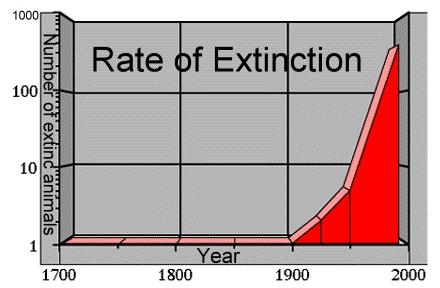74 species per year disappear forever!
 Extinction is an evolutionary process that leads to the disappearance of a taxon (genus, species, subspecies) or a population. When a species is extinguished her genetic heritage is lost. From the perspective of evolutionary extinction occurs independently of perturbation elements of great importance. A species can evolve into another (speciation) in response to small changes in the environment or in response to random changes in the genes. In any case, the extinction - such as speciation - is part of the natural evolutionary process of the living.
Extinction is an evolutionary process that leads to the disappearance of a taxon (genus, species, subspecies) or a population. When a species is extinguished her genetic heritage is lost. From the perspective of evolutionary extinction occurs independently of perturbation elements of great importance. A species can evolve into another (speciation) in response to small changes in the environment or in response to random changes in the genes. In any case, the extinction - such as speciation - is part of the natural evolutionary process of the living.
Biodiversity has increased since the appearance of life on Earth. The speed or rate of natural extinction rate (the number of species that become extinct per unit time) is evaluated according to the "life" of the species, ie, the average duration of their existence on Earth. Paleontologists have identified big five "mass extinction events" over the past 500 million years: at the end of the Ordovician, 440 million years ago, at the end of the Devonian, 365 million years ago, at the end of the Permian, 250 million of years ago, at the end of the Triassic, 205 million years ago and at the end of the Cretaceous period (with the disappearance of the dinosaurs). In all these phenomena of mass extinctions is estimated to have been lost 75-95% of the number of existing species.
The current rate of extinction, however, is not natural. The international scientific community that studies the natural systems and biodiversity shares the view that human intervention is causing a sixth mass extinction. It is very special because extinction is the first time it is caused, directly or indirectly, from a species that shares with other Planet. It is believed that the current rate of species extinction caused by the heavy intervention of the human species is at least a thousand times greater than the natural rate of extinction (Primack, 2001). The average life of a species, estimated on the basis of fossils found, is on average 11 million years for invertebrates and 1-2 million years for vertebrates (Barbault, 2001).
At present the lack of knowledge we have on the total number of living species actually prevents very accurate calculations of the current extinction rates as well as future projections of these rates. The first estimate was published in all probability that of Myers (1979) who spoke of a rate of extinction, due to the intervention of the human species, of 40,000 species per year, or over 100 species a day. The biologist Edward Wilson (1992) believes that the current rate of deforestation, assuming that the Earth 10 million species are present, they should disappear at least 27,000 species per year, or an average of 74 species per day.
In the report "Global 2000" led by U.S. President Jimmy Carter, published in 1980 and edited by a number of leading experts in environmental sciences, the biologist Thomas Lovejoy pointed at as reasonable estimate of global extinctions for 2000 to at least 500-600 thousand 3 to 10 million species on the existing (Barney, 1980).


 Extinction is an evolutionary process that leads to the disappearance of a taxon (genus, species, subspecies) or a population.
Extinction is an evolutionary process that leads to the disappearance of a taxon (genus, species, subspecies) or a population. 
